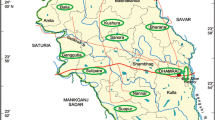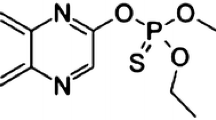Abstract
Analysis of pesticides during different seasons for pesticidal contamination in water samples of Tighra reservoir was carried out on gas chromatograph–electron capture detector with capillary columns following multiresidual analytical technique. Organochlorine pesticides, viz., hexachlorobenzene (HCB), \( \alpha \)-benzene hexachloride (BHC), \( \beta \)-BHC, \( \gamma \)-BHC, heptachlor, aldrin, \( \alpha \)-endosulfan, \( \beta \)-endosulfan, p,p-DDE, dieldrin, o,p-dichlorodiphenyldichloroethane (DDD), p,p-DDD, p,p-dichlorodiphenyltrichloroethane (DDT), and endrin, and organophosphorus pesticides, viz., choloropyrifos, methyl parathion, diazion, dicholorovos, ethion, malathion, and parathion, were detected in water samples during different seasons. However, the pesticide concentration varied during different seasons at different sites. The prominent reason of contamination is the use of pesticides (both organochlorine and organophosphorus) in the agricultural fields near Tighra reservoir. On the basis of our observations, more extensive monitoring studies need to be carried out, covering all wetlands of Madhya Pradesh to enforce the policies for the restricted application of pesticides in agricultural fields adjacent to wetlands.







Similar content being viewed by others
References
Agnihotri, N., Kulshresthra, G., Gajbhiye, V. T., Mohapatra, S. P., & Singh, S. B. (1996). Organochlorine insecticide residues in agricultural soils of the Indo-Gangetic plain. Environmental Monitoring and Assessment, 40, 279–288.
Anitescu, G., & Tavlarides, L. L. (2006). Supercritical extraction of contaminants from soils and sediments. Journal of Supercritical Fluids, 38, 167–180.
APHA, AWWA, & WEF. (2005). Standard methods for the examinaton of water and wastewater (21st ed.). Washington: American Public Health Association.
Atif, R. M., Muhammad, A. F., Ahmed, A., & Saqib, R. M. (2007). Field incurred chlorpyrifos and 3, 5, 6-trichloro-2-pyrifinol residues in fresh and processed vegetables. Food Chemistry, 103, 1016–1023.
Babu, V., Unnikrishnan, P., Anu, G., & Nair, S. M. (2011). Distribution of organophosphorus pesticides in the bed sediments of a backwater system located in an agricultural watershed: influence of seasonal intrusion of seawater. Achieves of Environmental Contamination and Toxicology, 60, 597–609.
Bao, L. J., Maruya, K. A., Snyder, S. A., & Zeng, E. Y. (2012). China’s water pollution by persistent organic pollutants. Environmental Pollution, 163, 100–108.
Central Pollution Control Board (CPCB) & Ministry of Environment and Forests (MOEF) (2006-07), 1999- 2005 report on water quality status of Yamuna River, Assessment and development of river basin series: ADSORBS/ 41.
Colin, B. (1999). Toxic organic chemicals. Environmental chemistry, 2nd edn., Chapter 6. New York: W.H. Freeman and Company.
El-Kabbany, S., Rashed, M. M., & Zayed, M. A. (2000). Monitoring of the pesticide levels in some water supplies and agricultural land, in El-Haram, Giza. Journal of Hazardous Materials, 72, 11–21.
Eqani, A., Malik, R. N., Alamdar, A., & Faheem, H. (2012). Status of organochlorine contaminants in the different environmental compartments of Pakistan: a review on occurrence and levels. Bulletin of Environmental Contamination and Toxicology, 88, 303–310.
Eqani, S. A. M. A. S., Malik, R. N., & Mohammad, A. (2011). The level and distribution of selected organochlorine pesticides in sediments from River Chenab, Pakistan. Environmental Geochemistry and Health, 33, 33–47.
Ghosh, S., Das, A. K., & Vass, K. K. (2000). DDT, HCH and endosulfan residues in the lower stretches of river Ganga. Central Inland Capture Fisheries Research Institute, 27, 161–164.
Hu, G., Dai, J., Mai, B., Luo, X., Cao, H., Wang, J., Li, F., & Xu, M. (2010). Concentration and accumulation features of organochlorine pesticides in the baiyangdian lake freshwater food web of North China. Archives of Environmental Contamination and Toxicologyi, 58, 700–710.
International Organization for Standards 2010 Technical committee 81. http://www.alanwood.net/pesticides/index.html. Accessed Jan 2010.
Lazarini, C. A., Lima, R. Y., Guedes, A. P., & Bernardi, M. M. (2004). Prenatal exposure to dichlorvos: physical and behavioral effects on rat offspring. Neurotoxicology and Teratology, 26, 607–614.
Loganathan, B. G., & Kannan, K. (1991). Time perspectives of organochlorine contamination in the global environment. Marine Pollution Bulletin, 22, 582–584.
Murison, D.J., Moore, D.C., McHenery, J.G., Robertson, N.A., & Davies, I.M. (1997). Epiphytic invertebrate assemblages and dichlorvos.
Nomen, R., Sempere, J., Chavez, F., Lopez, N. A., & Rovira, M. D. (2012). Measurement of pollution levels of organochlorine and organophosphorus pesticides in water, soil, sediment, and shrimp to identify possible impacts on shrimp production at Jiquilisco Bay. Environmental Science and Pollution Research, 19, 3547–3555.
Pimentel, D., Andow, D., Dyson-Hudson, R., Gatlahan, D., Jacobson, S., Irish, M., Kroop, S., Moss, A., Schreiner, I., Shepard, M., Thompson, T., & Vinzant, B. (1980). Environmental and social costs of pesticides: a preliminary assessment. Oikos, 34, 126–140.
Rao, R.J. (2008). Status and Conservation of aquatic species diversity in certain water bodies of Madhya Pradesh. Proceedings of Taal 2007. The 12th World lake Conference: 1993-2000.
Rehana, Z., Malik, A., & Ahmad, M. (1995). Mutagenic activity of the Ganges water with special reference to the pesticide pollution in the river between Kachla to Kannauj (U.P.), India. Mutation Research, 343, 137–144.
Singh, K. P., Sinha, M. D., & Dalwani, S. S. (2004). Impact assessment of treated/ untreated wastewaters toxicants discharged by sewage treatment plants on health, agricultural and environmental quality in the wastewater disposal area. Chemosphere, 55, 227–255.
Sujatha, C. H., Nair, S. M., & Chacko, J. (1999). Determination and distribution of endosulfan and malathion in an Indian estuary. Water Research, 33, 109–114.
Sun, Q., Zhu, L., & Dong, M. (2006). Risk assessment of organic pesticides pollution in surface water of Hangzhou. Environmental Monitoring Assessment, 117, 377–385.
Toan, V. D., Thao, V. D., Walder, J., Schmutz, H. R., & Ha, C. T. (2007). Contamination by selected organochlorine (OCPs) in surface soil in Hanoi, Vietnam. Bulletin of Environmental Contamination Toxicology, 78, 195–200.
Uchchariya, D. K. (2012). Study of nutrients and trophic status of Tighra Reservoir, Gwalior (Madhya Pradesh). India Journal of Natural Sciences Research, 2, 97–110.
UNEP. (1993). The Aral Sea: diagnostic study for the development of an action plan for the conservation of the Aral Sea. Kenya: Nairobi.
Voldner, E. C., & Li, Y. (1995). Global usage of selected persistent organochlorines. Science of the Total Environment, 160(161), 201–210.
Wang, L., Liang, Y., & Jiang, X. (2008). Analysis of eight organophosphorus pesticide residues in fresh vegetables retailed in agricultural product markets of Nanjing, China. Bulletin of Environmental Contamination Toxicology, 81, 377–382.
Acknowledgments
We are thankful to DST INSPIRE New Delhi for financial support (Mamta-IF 120834), IIT Mumbai for technical support, and to the Director, Indira Gandhi Academy of Environmental Education Research and Ecoplanning, Jiwaji University, Gwalior, for providing all facilities for conducting the research work.
Author information
Authors and Affiliations
Corresponding author
Rights and permissions
About this article
Cite this article
Mamta, Rao, R.J. & Wani, K.A. Monitoring of organochlorine and organophosphorus pesticide residues in water during different seasons of Tighra reservoir Gwalior, Madhya Pradesh, India. Environ Monit Assess 187, 684 (2015). https://doi.org/10.1007/s10661-015-4889-4
Received:
Accepted:
Published:
DOI: https://doi.org/10.1007/s10661-015-4889-4




